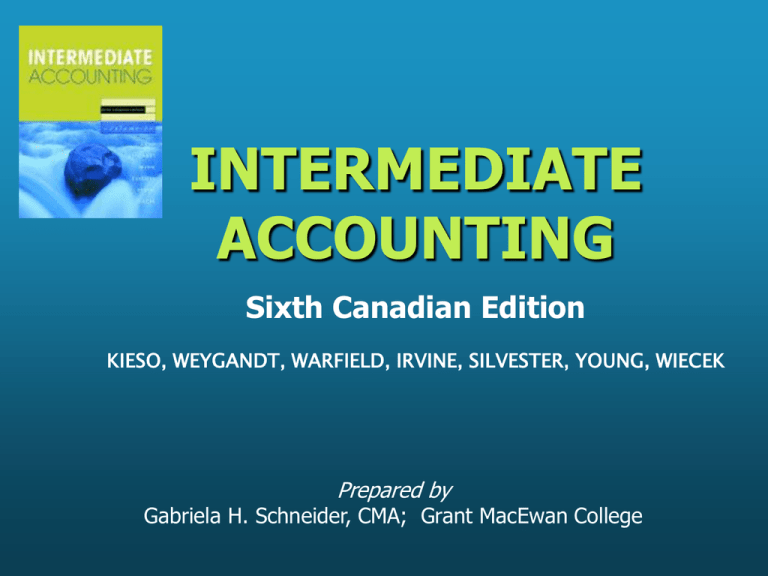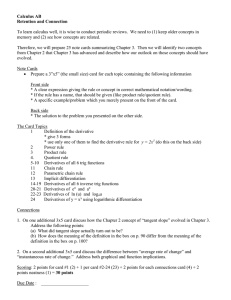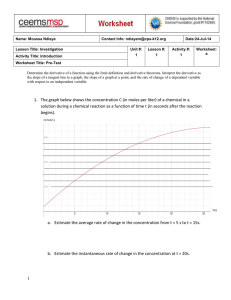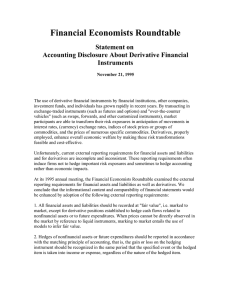
INTERMEDIATE
ACCOUNTING
Sixth Canadian Edition
KIESO, WEYGANDT, WARFIELD, IRVINE, SILVESTER, YOUNG, WIECEK
Prepared by
Gabriela H. Schneider, CMA; Grant MacEwan College
CHAPTER
18
Dilutive Securities and
Earnings per Share
Appendix 18B
Accounting for
Derivatives
Study Objectives
1. Explain who uses derivatives and why they are
used
2. Understand the basic guidelines for accounting
for derivatives
3. Describe the accounting for derivative financial
instruments
4. Describe the disclosure requirements for
traditional and derivative financial instruments
Derivatives
• Derivatives are financial instruments that create
rights and obligations, that transfer financial risk
from one party to the another party
• Used to reduce financial risks
• Price risk
• Credit risk
• Liquidity risk
• Cash flow risk
• Derivative instruments include
• Forwards
• Futures
• Options
Derivatives
• Traditional accounting does not
reported these instruments
• Movement is towards recognition and
reporting of these instruments, to
• Provide information on exposed risks
• Provide information on risk management
Derivatives
• Used by
• Producers and Consumers
• Lock in future revenues or costs
• Speculators and Arbitrageurs
• Maintain market liquidity
• Additional motivations to use derivatives
• Manage interest rate volatility
• Manage foreign exchange rate volatility
Derivative Instruments
• Financial forwards or financial futures
• Options
• Call Option
• Holder has the right, but not the obligation, to
purchase at a preset (strike or exercise) price
• Put Option
• Holder has the right to sell at a preset price
• Swaps
• Interest rate
Basic Principles of
Derivative Accounting
•
•
Currently no GAAP in place for derivative
accounting
General consensus exists for:
a) Measurement at fair value
b) Recognition of gains/losses from fair value
changes
c) Preclusion of special accounting related to
hedging
d) Increasing disclosure
Derivative Accounting Example
Given:
• Call option entered into January 2, 2002
• Option expires April 30, 2002
• Option to purchase 1,000 shares at $100 per
share
• Share market price on January 2, 2002 is
$100 per share
• Option is purchased for $400 (Option
Premium)
• Share price March 31st $120 per share
Accounting for Derivatives
Option Price Formula
Option
Intrinsic
=
Premium
Value
Market Price less
Strike (Exercise)
Price
Option
Premium
+
Time
Value
Option Value
Less
Intrinsic Value
= ($100 - $100) + ($400 - $0)
Journal Entries
Accounting for Derivatives
January 2
Temporary Investment (Call Option)
Cash
400
400
March 31
Temporary Investment (Call Option)
20,000
Unrealized Holding Gain/Loss
20,000
Intrinsic Value = 1,000 shares ($100 - $120)
March 31
Unrealized Holding Gain/Loss
Temporary Investment (Call Option)
Time Value = ($400 - $100)
300
300
Accounting for Derivatives
April 1
Cash
Loss on Settlement of Call Option
Call Option
Temp. Investment
400
20,000
20,100
20,000
400
20,100
Unrealized Gain
or Loss
300
Reported on
March 31st
Balance Sheet, with
Call Option balance
20,000
Unrealized
Less: Loss
Net Income
Call Option
20,100
20,000
400
19,600
Hedging
• Used to manage interest rate and
foreign exchange risk
• Fair Value Hedge
• To offset exposure to fair value changes of
• Recognized asset or liability, or
• Unrecognized firm commitment
• Examples are
• Interest rate swap
• Put option
Interest Rate Swap
A pays B at a fixed (or floating) rate
Party A
Financial
Intermediary
Party B
B pays A using the opposite rate of A
Interest Rate Swap
Given:
A enters into a 5-year interest rate swap with B
Terms are:
A will receive payments at the fixed rate of 8%
A will pay at variable rate (6.8% when contract
entered into)
Principal sum involved is $1,000,000
Interest Rate Swap
• No entry required when swap entered into
• Fair value of the swap reported on the
Balance Sheet
• Any gains or losses reported on the
Income Statement
Futures Contract
• Gives the holder the right to purchase
at a preset price
• Unrealized gains or losses are recorded
• Gain or loss arises when the spot price is
different than the forward (contract) price
Disclosure Requirements
•
Include the following:
1) Terms and conditions of instrument
2) Interest rate risk
3) Credit risk, including significant
concentrations
4) Fair value of any and all recognized and
unrecognized financial instruments
5) Hedges
1) Description of hedge
2) Type of hedge used
COPYRIGHT
Copyright © 2002 John Wiley & Sons Canada, Ltd.
All rights reserved. Reproduction or translation of
this work beyond that permitted by CANCOPY
(Canadian Reprography Collective) is unlawful.
Request for further information should be
addressed to the Permissions Department, John
Wiley & Sons Canada, Ltd. The purchaser may
make back-up copies for his / her own use only and
not for distribution or resale. The author and the
publisher assume no responsibility for errors,
omissions, or damages, caused by the use of these
programs or from the use of the information
contained herein.








